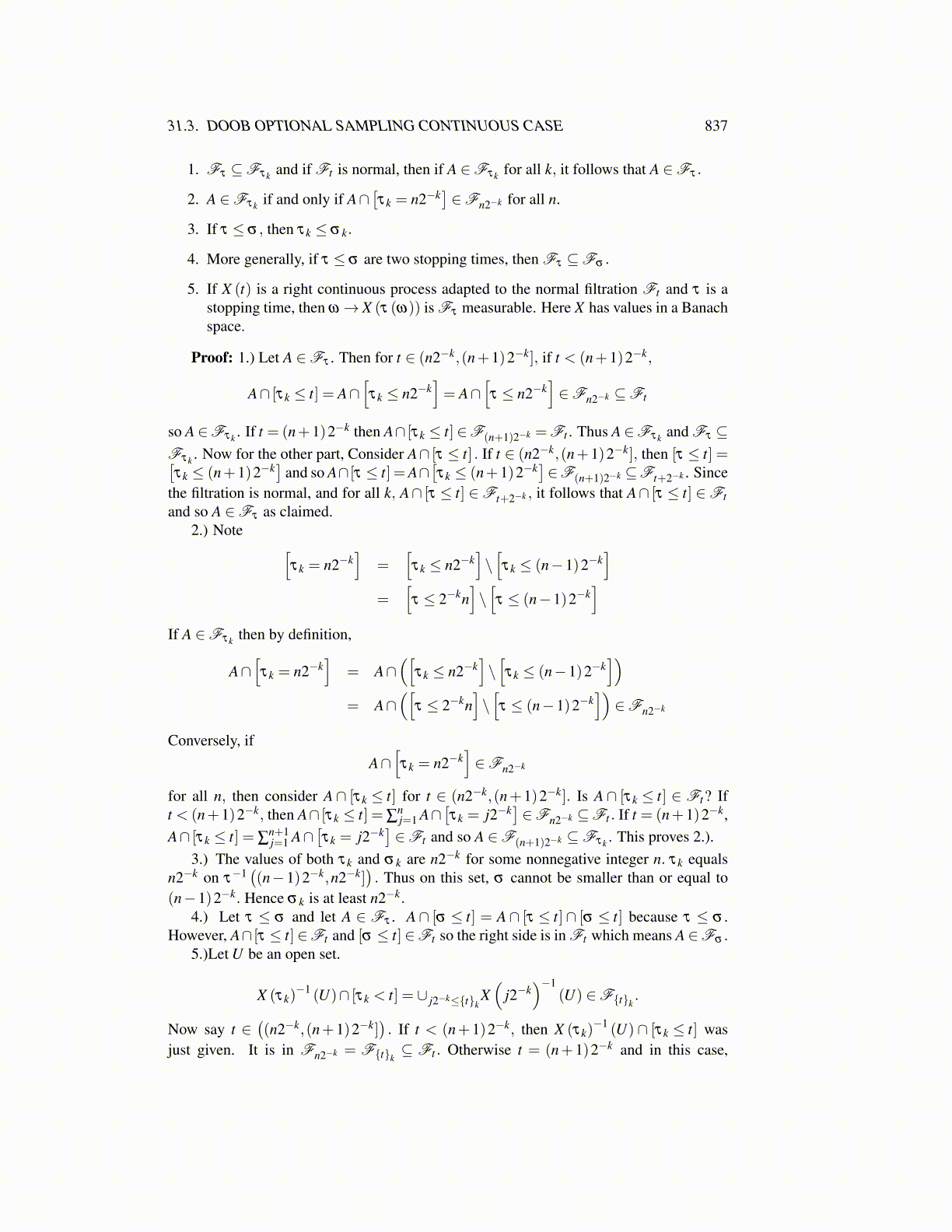
31.3. DOOB OPTIONAL SAMPLING CONTINUOUS CASE 837
1. Fτ ⊆Fτk and if Ft is normal, then if A ∈Fτk for all k, it follows that A ∈Fτ .
2. A ∈Fτk if and only if A∩[τk = n2−k
]∈Fn2−k for all n.
3. If τ ≤ σ , then τk ≤ σ k.
4. More generally, if τ ≤ σ are two stopping times, then Fτ ⊆Fσ .
5. If X (t) is a right continuous process adapted to the normal filtration Ft and τ is astopping time, then ω→ X (τ (ω)) is Fτ measurable. Here X has values in a Banachspace.
Proof: 1.) Let A ∈Fτ . Then for t ∈ (n2−k,(n+1)2−k], if t < (n+1)2−k,
A∩ [τk ≤ t] = A∩[τk ≤ n2−k
]= A∩
[τ ≤ n2−k
]∈Fn2−k ⊆Ft
so A∈Fτk . If t = (n+1)2−k then A∩ [τk ≤ t]∈F(n+1)2−k =Ft . Thus A∈Fτk and Fτ ⊆Fτk . Now for the other part, Consider A∩ [τ ≤ t] . If t ∈ (n2−k,(n+1)2−k], then [τ ≤ t] =[τk ≤ (n+1)2−k
]and so A∩ [τ ≤ t] =A∩
[τk ≤ (n+1)2−k
]∈F(n+1)2−k ⊆Ft+2−k . Since
the filtration is normal, and for all k, A∩ [τ ≤ t] ∈Ft+2−k , it follows that A∩ [τ ≤ t] ∈Ftand so A ∈Fτ as claimed.
2.) Note [τk = n2−k
]=
[τk ≤ n2−k
]\[τk ≤ (n−1)2−k
]=
[τ ≤ 2−kn
]\[τ ≤ (n−1)2−k
]If A ∈Fτk then by definition,
A∩[τk = n2−k
]= A∩
([τk ≤ n2−k
]\[τk ≤ (n−1)2−k
])= A∩
([τ ≤ 2−kn
]\[τ ≤ (n−1)2−k
])∈Fn2−k
Conversely, ifA∩[τk = n2−k
]∈Fn2−k
for all n, then consider A∩ [τk ≤ t] for t ∈ (n2−k,(n+1)2−k]. Is A∩ [τk ≤ t] ∈ Ft? Ift < (n+1)2−k, then A∩ [τk ≤ t] = ∑
nj=1 A∩
[τk = j2−k
]∈Fn2−k ⊆Ft . If t = (n+1)2−k,
A∩ [τk ≤ t] = ∑n+1j=1 A∩
[τk = j2−k
]∈Ft and so A ∈F(n+1)2−k ⊆Fτk . This proves 2.).
3.) The values of both τk and σ k are n2−k for some nonnegative integer n. τk equalsn2−k on τ−1
((n−1)2−k,n2−k]
). Thus on this set, σ cannot be smaller than or equal to
(n−1)2−k. Hence σ k is at least n2−k.4.) Let τ ≤ σ and let A ∈ Fτ . A∩ [σ ≤ t] = A∩ [τ ≤ t]∩ [σ ≤ t] because τ ≤ σ .
However, A∩ [τ ≤ t]∈Ft and [σ ≤ t]∈Ft so the right side is in Ft which means A∈Fσ .5.)Let U be an open set.
X (τk)−1 (U)∩ [τk < t] = ∪ j2−k≤{t}k X
(j2−k
)−1(U) ∈F{t}k .
Now say t ∈((n2−k,(n+1)2−k]
). If t < (n+1)2−k, then X (τk)
−1 (U) ∩ [τk ≤ t] wasjust given. It is in Fn2−k = F{t}k ⊆ Ft . Otherwise t = (n+1)2−k and in this case,